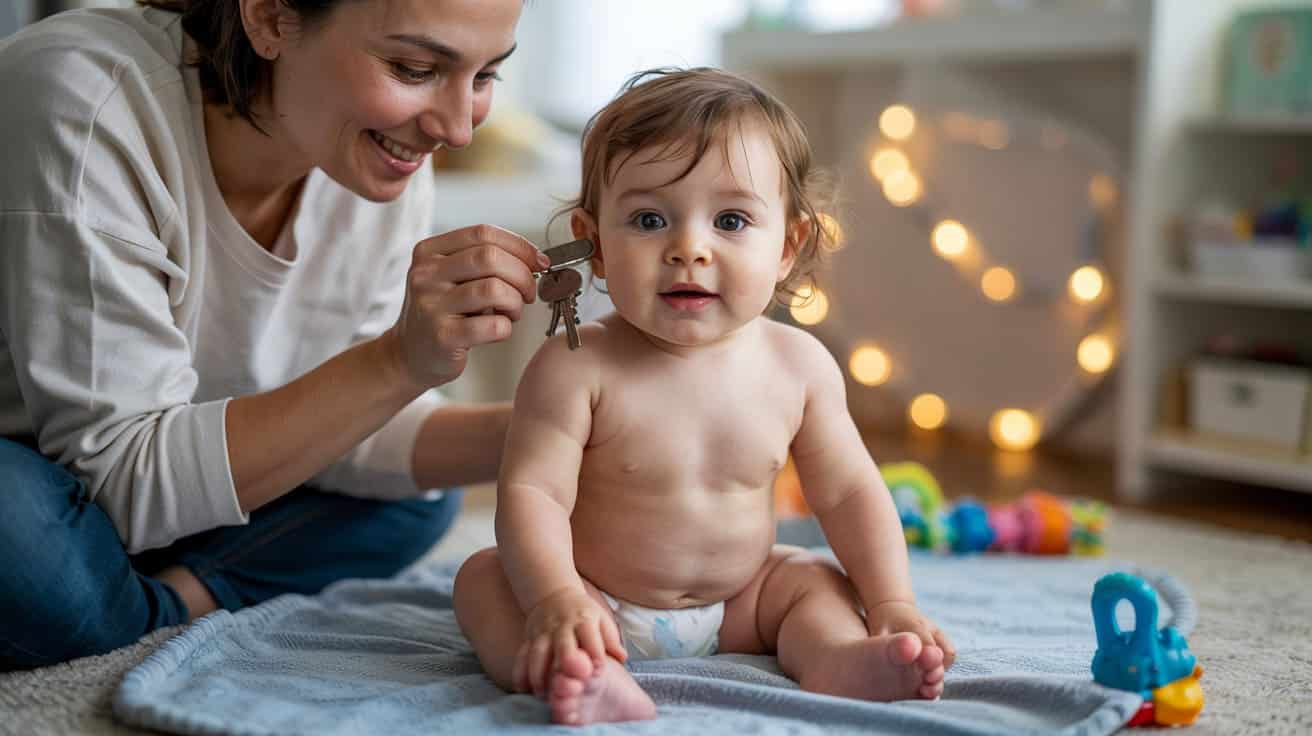Are you worried your baby might not hear well? You are not alone. Many parents watch for signs that their baby can hear them. Early hearing is key for learning to talk and connect with you. This guide will show you how to check your baby’s hearing at home in simple steps. It also explains what signs to look for and when to see a doctor for help.
In This Article
- Why Baby Hearing Matters Early
- Signs Your Baby Might Have Hearing Issues
- How to Test Baby’s Hearing at Home (Step-by-Step)
- Which Types of Hearing Tests Can Be Done by Parents at Home?
- Observe Reactions to Sounds (by Age Group)
- When to See a Doctor or Audiologist
- Professional Testing vs. At-Home Checks
- Equipment and Precision
- FAQs
Why Baby Hearing Matters Early
Most babies get a hearing check soon after birth. In the United States, over 98% of newborns have a hearing screening before leaving the hospital. Early tests help catch problems that might delay speech and learning. Good hearing lets your baby hear you sing, laugh, and speak. This is how babies start learning language from day one.
Hearing loss can slow a child’s speech, language, and social growth. Even a mild loss can make it hard for them to learn. Experts say that getting help early gives a baby the best chance to reach normal milestones.
According to the CDC: “If you think that a child might have hearing loss, ask the child’s doctor for a hearing screening as soon as possible. Do not wait!”.
Early action can make a big difference in your baby’s life. In fact, health leaders stress that screening and early care in childhood can reduce the impact of hearing loss.
Signs Your Baby Might Have Hearing Issues
How can you tell if your baby might have a hearing problem? Watch for early signs. Use this baby hearing checklist to note any concerns:
-
No startle at loud sounds: Your baby does not jump or blink when there is a sudden loud noise. Newborns should react with a startle reflex to loud sounds.
-
Not turning toward sounds by 6 months: Babies typically turn their head or eyes toward a sound by about 4 to 6 months old. If your baby does not look toward noises by this age, it may be a warning sign.
-
Not responding to name: By 7 to 9 months, babies usually recognize their name and look at you when called. If your baby does not respond when you call their name, have their hearing checked.
-
Not babbling or saying simple words: By around 1 year, most babies say “mamama” or “dadada” or a first word. If your baby is quiet or not babbling by 6-10 months, it could be due to hearing issues.
-
Only reacts to some sounds: Your baby might hear some noises but not others. For example, they react to a loud drum but not to your voice. Inconsistent hearing can signal a problem.
-
Turns only when seeing you: Sometimes a baby might seem to ignore sounds. If your baby looks up when they see you but not when you call from outside their view, it may mean they did not hear the call.
-
Pulling at ears often: Some babies with ear discomfort or hearing trouble pull or scratch at their ears frequently. This can also be a sign of ear infection, but it is worth noting.
If you notice one or more of these signs, talk to your pediatrician. No single sign means a hearing loss for sure. But these are red flags. Keep a log of what you observe. This checklist can guide you on when to seek further evaluation.
How to Test Baby’s Hearing at Home (Step-by-Step)
You can try simple steps at home to see how your baby reacts to sound. This is not a formal test, but it helps you notice potential issues. Make it a fun and gentle process. Here is a step-by-step guide for parents:
Step 1: Pick a Quiet Time and Place
Choose a time when your baby is awake and content. Go to a quiet room with no TV, music, or noisy appliances running. A calm setting helps your baby focus on new sounds.
Step 2: Position Your Baby Comfortably
Hold your baby in your lap or have them sit safely with support. Make sure they are not crying or fussing. A relaxed baby is more likely to respond to sounds.
Step 3: Make a Gentle Sound Out of View
Stand a few feet behind your baby or off to the side where they cannot see you. Make a soft sound that your baby might find interesting. You can jingle a set of keys, shake a rattle, or clap your hands softly. Be sure your baby cannot see the object – you want them to react to the sound, not the sight. Watch for any reaction like widening eyes, a sudden stop in movement, or a little jump.
Step 4: Call Your Baby’s Name
While staying out of your baby’s line of sight, say their name in a friendly voice. You can also try other familiar sounds, like making a “mmm” humming sound or a gentle “psst.” See if your baby turns their head or shoulders toward the sound. A baby with normal hearing will often search for your voice by 6 to 7 months of age.
Step 5: Test One Ear at a Time
Now check responses on each side. Make a sound on your baby’s right side (ring a bell, for example), then later on the left side. Do they turn their head both ways? This can hint if one ear might be stronger than the other. Note if your baby consistently does not turn one way.
Step 6: Use Different Volume Levels
Try a very soft sound and a moderate sound. For instance, whisper from behind your baby and see if they notice. Later, clap your hands a bit louder (not too loud to scare them). A baby with normal hearing should react in some way to both quiet and louder noises when alert. If they only notice very loud sounds, it could mean mild hearing loss.
Step 7: Observe and Note Reactions
Pay close attention to what your baby does. Do they startle at the clap? Do they coo or quiet down when you speak? Some babies will smile or get excited when they hear a parent’s voice. Any response – even a change in breathing or a pause in sucking (for a young infant) – counts as noticing the sound. If your baby shows no response to a sound, try another sound to confirm.
Step 8: Avoid Over-testing in One Session
Do not repeat the same sound too many times. Babies may get used to a sound if they hear it over and over, and then they might stop responding. This is called habituation. For example, if you crinkle paper behind them five times in a row, the first time they might turn, but by the fifth time they might tune it out. So, use a few different sounds and give breaks.
Step 9: Keep It Playful
Stay positive and make it a little game. After you finish a sound test, come around to smile and praise your baby. You want the experience to be fun, so your baby stays engaged. If your baby gets upset or tired, stop and try again later.
After doing these steps, you will have a sense of how your baby reacts to sound at home. Remember, if your baby is very young (under 3 months), their responses will be subtle. At that age, a baby might only startle or blink at sounds. As they get older, their responses (like turning toward sounds) become clearer. Use the age guidelines in the next section to know what to expect.
Which Types of Hearing Tests Can Be Done by Parents at Home?
Parents often ask if there are hearing tests they can do on their own. The methods at home are limited to observation and some simple tools. Here are a few ways you can check hearing at home:
Sound Response Tests
This is basically what you did in the step-by-step guide above. You create different noises and watch your baby’s reaction. Try various sound sources (a bell, a toy, your voice) at different locations and volumes. Note what your baby reacts to or ignores. This informal test can hint at hearing ability.
For example, if your baby always reacts to a loud clap but never to a soft voice, it suggests they hear louder sounds better than quieter ones.
App-Based or Online Hearing Tests
There are smartphone apps and online tools that play tones at different frequencies (pitches) and volumes. Typically, you wear headphones and see if you (or your child, if old enough) can hear the beeps. For a baby, a parent might have to observe the baby’s behavior when tones play.
Keep in mind these are more useful when a child is a bit older and can cooperate by pointing or indicating when they hear a sound. With a very young baby, you would still be looking for the same reactions (startle, looking toward sound).
These tools can give a basic idea of hearing ranges, but use them with caution. The results are not as exact as a clinical test.
Home Whisper Test (for older babies)
As your child grows into a toddler, you can try simple hearing games. For instance, from about 2 years old, you might whisper a simple word or instruction from behind them and see if they hear you. This is not precise, but it can alert you to possible hearing difficulties in everyday situations.
What About “Speech-in-Noise” Tests?
You might read about tests where speech is played over background noise. At home, this is hard to do with a baby. Speech-in-noise tests are usually done by professionals or with older children. They check if a child can understand words with chatter or noise in the background. This is beyond the scope of a baby at home, so you do not need to worry about this for infants.
Remember that no at-home test can diagnose hearing loss for sure. These methods only give you clues. They might tell you that further checking is needed. If you have any concerns from your at-home tests, schedule a professional exam.
Note: There are simple devices sold as “at-home hearing checkers,” but use judgment. Ensure any app or device is from a credible source (some hospitals or clinics provide online tests). Even then, treat the results as a first look only. Always follow up with an audiologist for a true evaluation.
Observe Reactions to Sounds (by Age Group)
Babies react to sounds differently as they grow. Knowing what is typical for each age can help you gauge your baby’s hearing. Here are age-group milestones for hearing and listening:
-
Birth to 3 Months: Newborns will startle or blink at sudden loud sounds. A loud clap might make them jump or fan out their toes. They are soothed by your gentle voice and may smile when spoken to. By 2-3 months, babies coo and make pleasure sounds, responding to you talking by making noises of their own.
-
4 to 6 Months: At this stage, babies start to turn their head or eyes toward new sounds. If you jingle keys, a 5-month-old will often look to find the noise. They notice changes in your tone of voice (for example, if you speak happily or sternly). Many begin babbling (“ba-ba” or “ga-ga” sounds) and will babble back when you talk. They also enjoy toys that make sounds like rattles and may get excited by music.
-
7 to 12 Months: Babies become much more active listeners. By 7 months, many babies respond to their own name. They might crawl or move toward a familiar voice. They recognize common words like “bottle,” “mommy,” or “bye-bye”. If you say “no,” a baby around 9-12 months may pause or stop briefly, showing they heard you. They also use more babbling sounds themselves, and by 12 months might say one or two real words (like “Mama” or “up”). Games like peek-a-boo are popular, and a hearing baby will listen and giggle during these social play times.
-
1 to 2 Years: (Technically beyond “baby,” but important to mention.) Toddlers should be able to point to a few body parts when asked (“Where is your nose?”) by around 18 months. They follow simple commands like “Come here” or “Bring me the ball.” They will also continue to build their word list. By age 2, kids often use two-word phrases (“more milk,” “go out”). If a child this age is not doing these, hearing should be checked.
Use these milestones as a general guide. Every baby is unique, and reaching a milestone a bit late does not always mean something is wrong. However, if your baby consistently isn’t doing many of the things in their age range, it’s worth discussing with a pediatrician. For example, if by 9 months your baby never turns when you call them from behind, that is a sign to act.
When to See a Doctor or Audiologist
It is critical to get professional help if you suspect any hearing issues. Acting early can prevent delays in speech and development. Here are situations when you should take your baby to a doctor or pediatric audiologist:
-
Failed Newborn Screening: If your baby did not pass the hospital hearing screening, follow up immediately as instructed. Do not delay the repeat testing. The goal is a full test by 3 months of age for any baby who didn’t pass the initial screen.
-
Missed Newborn Screening: If your baby was born at home or for some reason did not get a hearing check by 1 month old, schedule one now. All infants should be screened by 1 month of age.
-
Observable Warning Signs: Any of the checklist signs mentioned earlier (no reaction to loud sounds, not turning to sound by 6 months, etc.) should be discussed with a doctor. Trust your observations. If you have been monitoring and see possible issues, ask for a hearing evaluation. Always trust your instincts and find a pediatric audiologist if you feel something is off. The sooner the better.
-
Delayed Milestones: If your baby isn’t babbling or attempting to speak by the expected time, consult your doctor. Sometimes a speech delay can be due to hearing loss. For instance, not babbling by around 6-9 months or not saying any words by 15 months should be checked.
-
Frequent Ear Infections or Risk Factors: Chronic ear infections can cause temporary hearing loss due to fluid in the ear. Over time, repeated infections might affect hearing permanently. If your baby has had many ear infections, it’s wise to get a hearing test to be safe. Also, if there is a family history of childhood hearing loss or if baby had conditions like meningitis (which can cause hearing damage), let your doctor know. They may suggest more frequent hearing tests.
-
Parental Concern: Even if others (or even your pediatrician initially) say “wait and see,” you can request a hearing test. You know your baby best. If you still feel something isn’t right with how your baby hears, get a professional hearing test for peace of mind. Early Hearing Detection programs say that earlier intervention (by 6 months old) is vital if a hearing loss is confirmed.
Seeing a pediatric audiologist does not mean you are declaring there is a problem – it is a check, like an eye exam. If nothing is wrong, you will be relieved. If there is an issue, you will have caught it early when you can do the most about it. Pediatric audiologists specialize in testing babies and young children. The tests are painless and can often be done while the baby is asleep or very calm.
Professional Testing vs. At-Home Checks
At-home checks are helpful, but they are not a substitute for professional hearing tests. It’s important to understand the differences:
Equipment and Precision
At home, you have only your voice or household sounds. Professionals use advanced equipment. They perform tests like Auditory Brainstem Response (ABR) and Otoacoustic Emissions (OAE) on babies. In an ABR test, tiny sensors measure how the baby’s brain responds to sound.
In an OAE test, a small earpiece plays soft sounds and records the inner ear’s response. These can detect even mild hearing loss that a parent might not notice.
Accuracy
Home observations can tell you if a baby hears loud versus soft sounds, but they cannot measure the exact level of hearing. Audiologist tests find the softest sounds your baby can hear at different pitches. They also check each ear separately.
This detailed information is crucial if there is a hearing issue. For example, a baby might hear low-pitch sounds but not high-pitch sounds – only a professional test will catch that nuance.
Difficulty of Testing Babies
It’s not easy to know what a baby hears because they cannot tell us. Audiologists have special methods for each age. For an infant, they often have the baby rest quietly and use ABR, which doesn’t need the baby to respond actively.
At home, you might not notice subtle signs. A baby could have partial hearing loss and still startle at very loud noise, which might fool you into thinking hearing is fine.
When Home Checks Are Not Enough
If your home tests make you suspect an issue (or if you’re simply unsure), a professional exam is needed. You cannot fully test a baby’s hearing at home – only a trained audiologist can do that with the right tools.
The experts will explain the results and what they mean. They can tell if the hearing loss is temporary (for example, due to fluid in the ear) or permanent.
Safety and Comfort
Parents sometimes worry about the test process for infants. Rest assured, clinical hearing tests for babies are safe and do not hurt. The baby might even sleep through an ABR test. There are no needles or invasive steps.
At most, your baby might get a bit restless from having little headphone cups on their ears or stickers on their skin for sensors. But there is no pain at all. Knowing this, you should never hesitate to get the test done.
Interpretation
After at-home checks, you might have notes like “didn’t respond to quiet voice on left side.” A professional will do a thorough check and either confirm a concern or put it to rest.
If a problem is found, they will guide you on next steps (which could include hearing aids, early intervention programs, or seeing an ENT doctor to explore causes). If no problem is found, you can breathe easier and simply continue to monitor your child’s developmental milestones.
At-home hearing checks as a first screening. They are good for noticing red flags. But to know for sure, you need a formal hearing test.
One analogy: You can take your child’s temperature at home and see a fever, but if you suspect something serious, you still go to the doctor for tests. It’s the same with hearing. Use home observations to inform yourself, then get expert confirmation.
FAQs
Q1: How can I tell if my baby has hearing loss?
Watch how your baby reacts to sound. A newborn should jump or blink at loud sounds. At 4 to 6 months, your baby should turn toward voices or toys that make noise. At 7 to 9 months, your baby should look when you call their name. If your baby only reacts to very loud sounds, there may be a hearing problem. Use the checklist in this guide. If you notice signs, talk to your doctor.
Q2: At what age do babies respond to their name or sounds?
Babies respond to sound from birth. Newborns may blink or jump when they hear loud noises. At 4 to 6 months, they look toward sound. By 7 months, most babies turn when you say their name. By 9 to 12 months, your baby should know simple words like “no” or “bye.” If your baby does not respond to their name by 1 year, get their hearing checked.
Q3: Can I really test my baby’s hearing at home?
You can try simple tests at home. Clap your hands or call your baby’s name. Watch if they turn or react. These tests help you see if your baby notices sound. But they do not show full results. Only a doctor or audiologist can test hearing the right way. If you have doubts, ask for a hearing test.
Q4: Are hearing tests for infants safe and not painful?
Yes, they are safe and do not hurt. Doctors use soft sounds and small stickers for the test. There are no needles or loud noises. Most babies sleep during the test. The audiologist will tell you the results after the test.
Q5: My baby passed the newborn hearing screen. Can hearing loss develop later?
Yes, it can happen. Some babies lose hearing after birth. It may happen due to illness, injury, or family history. Keep watching your baby’s hearing and speech. If you feel something is not right, ask for another hearing test. Hearing can change over time.
Q6: What should I do if I suspect my baby has a hearing problem?
Act early. Call your doctor or ask for a hearing test. Do not wait or hope it gets better. Early help gives your baby the best chance to grow and learn well. While you wait, keep talking, reading, and playing with your baby. But the most important step is to get a proper hearing test.
Conclusion
Your baby’s hearing is key to their growth. Good hearing helps your baby learn words and connect with you. Most babies hear well, but some may need help. You now know how to check signs and try safe steps at home.
If you feel unsure or see warning signs, talk to your doctor. Ask for a hearing test from an expert. Early action gives your baby the best chance to grow and learn with ease.
Trust your gut. Stay alert. Take action early. Your care can open a world of sound for your baby.











